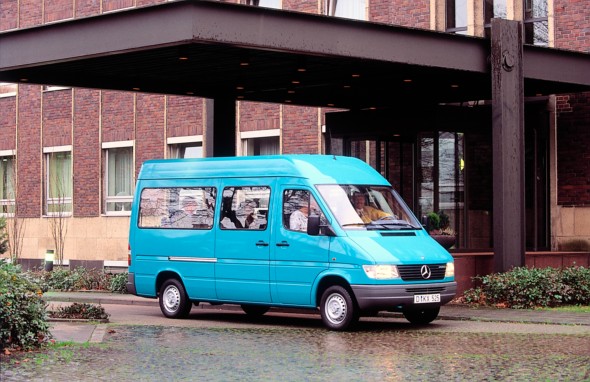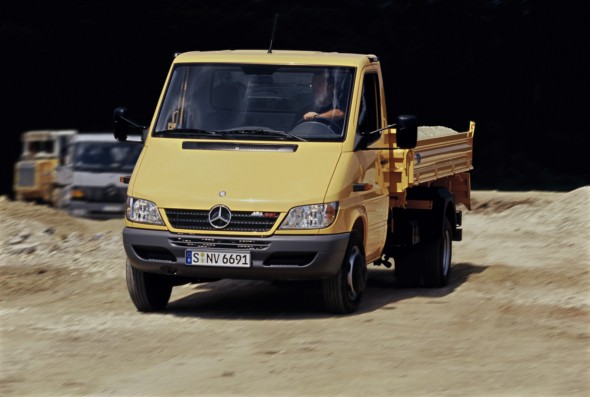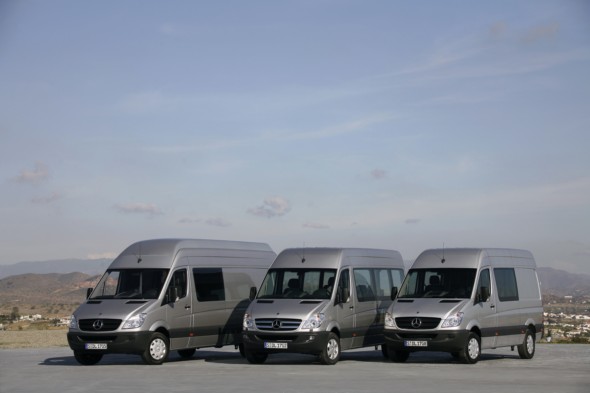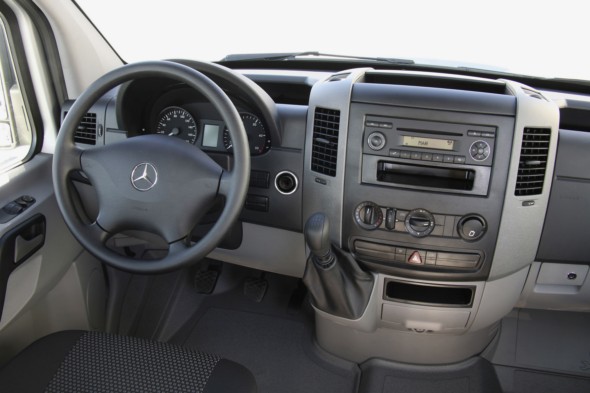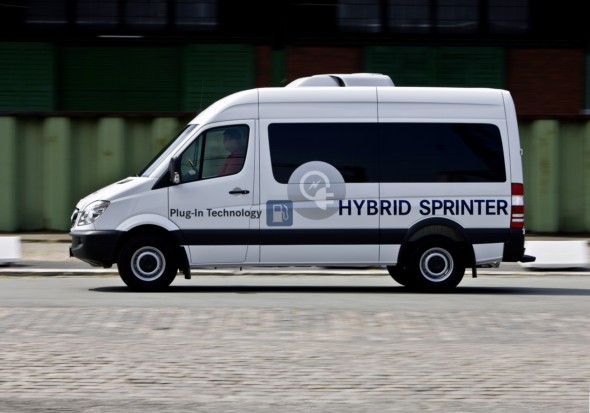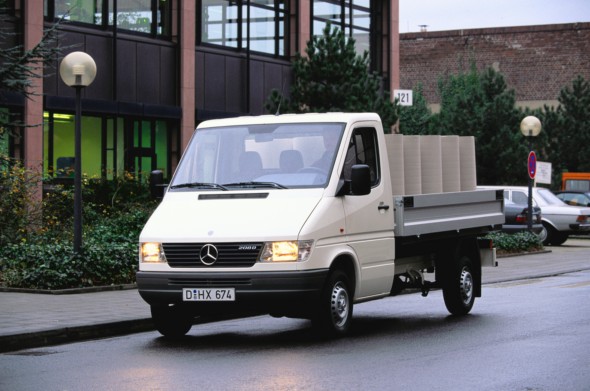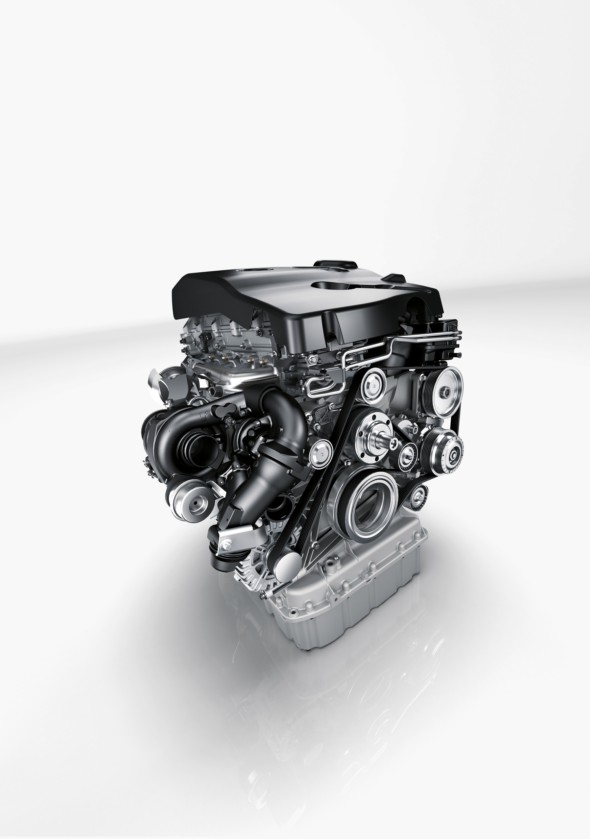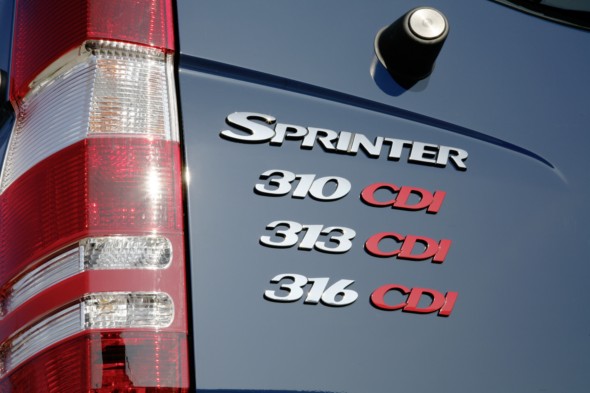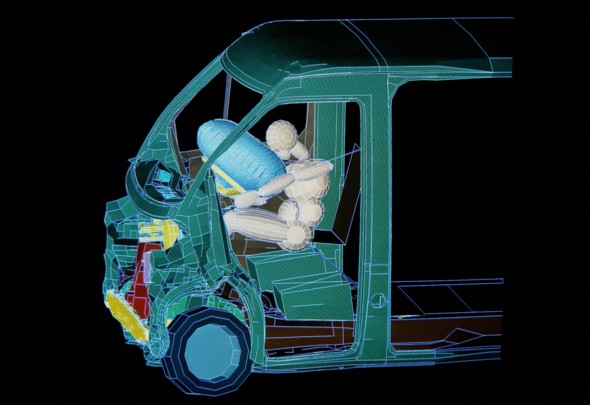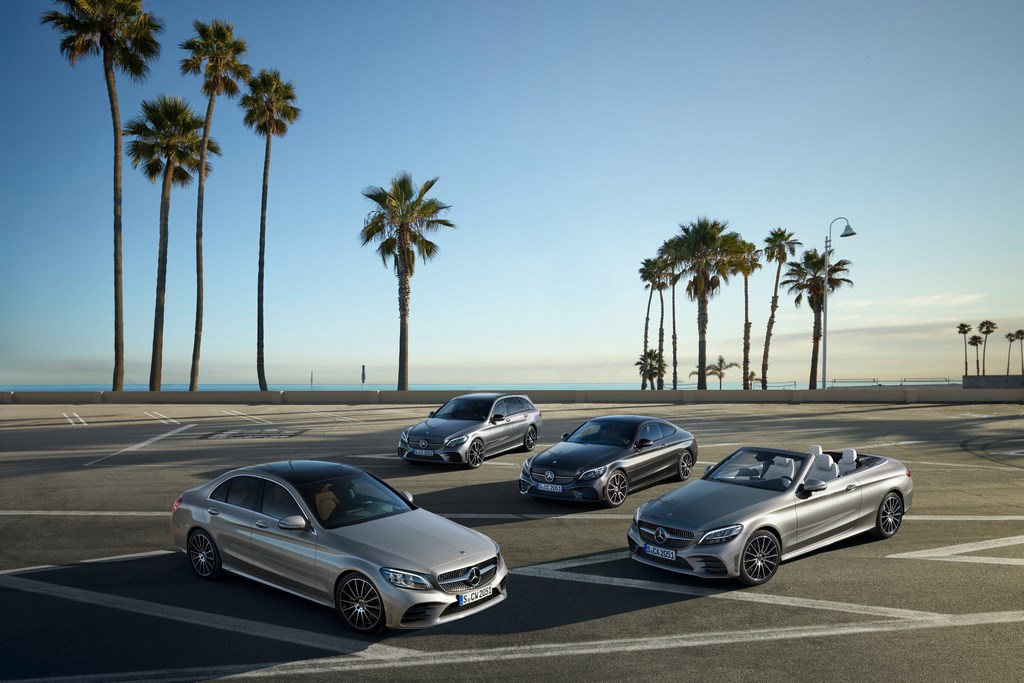Classic of modern times: the Sprinter van celebrates its 15th anniversary
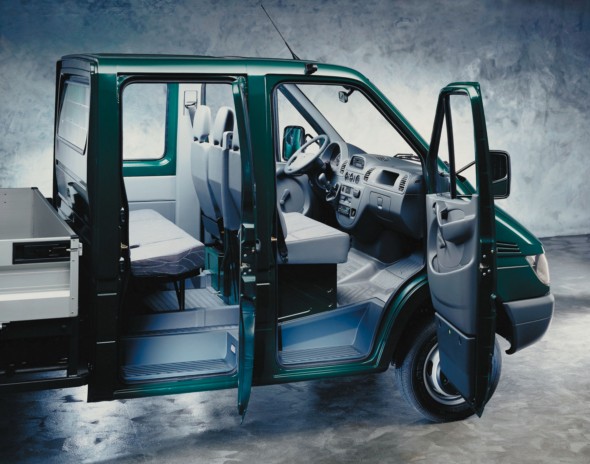
- Spearhead of major strategic product initiative
- Standard for engineering, comfort and safety
- More than two million units manufactured
Stuttgart – From its 1995 launch the Sprinter already was in a class of its own: semi-forward control, high-traction rear-wheel drive, timelessly modern looks, spacious cab, an extensive engine range rounded off by a direct-injection diesel unit which was as powerful as it was economical.
And it was the company’s first commercial vehicle to be known by a name instead of an abbreviation or combination of numbers. But it did not retain that privilege alone for long: in an unprecedented tour de force, with the Sprinter making the start, and with Vito, Vario, Actros and Atego soon to follow, within 36 months completely new vans and trucks were on the market in all weight classes. Even though all have been thoroughly further developed or even entirely reengineered in the meantime, to this day they form the backbone of the Mercedes-Benz brand’s commercial vehicles.
With the start of production in January 1995, the Sprinter not only took the lead in this grand strategic product initiative. It had some very big shoes to step into at the same time: it was the successor to the T1 van, also referred to internally as the “Bremen” van, named after the site in North Germany where it was first manufactured. This Bremen van was regarded as a paradigm of longevity, solidity and reliability. In 18 long production years Mercedes-Benz built almost a million units of this model series with the distinctive, angular, short bonnet. With a longitudinally installed front-mounted engine and rear-wheel drive the Sprinter took up this successful technical concept.
Four gross weights, three engines
Also like its predecessor, the Sprinter began its career with four gross vehicle weights from 2.59 to 4.6 tonnes. It was available as a panel van, crewbus, chassis, pickup, and with a crewcab, all of these versions in three wheelbase lengths, and the closed-body variants additionally with two roof heights. The Sprinter targeted mainly the 3.5 tonne GVW class, this tonnage marking an important dividing line in a great many European countries as far as driving licences and traffic regulations were concerned.
The Sprinter lined up with three different engines. Interest focused mainly on the OM 602 DELA, a direct-injection turbodiesel with 2.9 litres displacement and five cylinders. With its output of 90 kW and peak torque of 280 Newton metres it took performance to new record levels for vans of this type. Distributor pump, electronic control and exhaust gas recirculation are characteristics of this engine.
It was complemented by a tried and tested, smooth-running pre-chamber diesel engine developing 58 kW from 2.3 litres piston displacement and by a zippy four-cylinder petrol unit (likewise with a displacement of 2.3 litres) delivering power of 105 kW. A newly developed five-speed manual transmission transferred the power to the rear axle. For each version there were at least two different final drive ratios to choose from. As alternative to the manual box, a fully automatic four-speed torque converter transmission followed a short time later.
The new Mercedes-Benz van was good for a road speed of up to 160 km/h and not only lived up to its name, but quickly put tyre manufacturers on the spot, since few tyres at the time boasted the proper speed index.
Highest safety standards
Not just high performance, highest safety too played a crucial role in the Sprinter. From the outset the Sprinter had disc brakes on all wheels. The anti-lock brake system (ABS) and an automatic brake differential were standard equipment in many countries. And then there was the driver airbag, also a standard feature in Germany and many other countries. With that the Mercedes-Benz Sprinter set new standards for safety in its category, as it did in many other areas.
Along with investing intensive effort in the advancement of conventional drive technology, the engineers also developed alternative drive systems to the production stage in combination with the Sprinter. One year after the launch of the new van it was already available as the electrically powered 308 E Sprinter. The water-cooled asynchronous motor, output 40 kW, got its energy from maintenance-free lead-gel batteries. The energy rating of 29 kWh sufficed to travel a distance of 65 to 80 km.
Natural gas drive to match the petrol engine
At the same time the first NGT Sprinters with natural gas drive (NGT=Natural Gas Technology) were being used by customers. The engine, featuring a new kind of sequential injection technology, developed 92 kW and practically could take on the conventional petrol engine for performance. With gas cylinders mounted underfloor, the vehicles had a range of 200 to 250 km. In spring 1997 this Sprinter with natural gas drive went into series production. Later, variants powered by liquefied gas – also called liquid petroleum gas or LPG – were added to the range.
It was also 1997 when a first version with all-wheel drive expanded the Sprinter model range. This Sprinter for difficult traction conditions, as could be encountered in snow or at building sites, had an electro-pneumatically engageable front-wheel drive – optionally also an additional off-road ratio and a locking differential – and was built much higher off the ground for more clearance. Permanent all-wheel drive would follow later.
Production record in 2005
And so the Sprinter quickly set out to outstrip the proven T1. At the Düsseldorf van plant where the T1 was manufactured during the second half of its life, Mercedes-Benz initially planned the daily output of 400 Sprinters in two shifts. However, after a very few years the annual production levelled out at more than 500 vans per day in three-shift operation. Production pushing the limits of capacity became the normal case for the Sprinter. At the end of its career, in 2005 the first Sprinter even attained a new production record with around 150,000 units – a great compliment for a very mature van in the prime of life.
It owed this to a tailor-made concept. The numerous body and weight variants of the Sprinter scored a bull’s-eye with potential buyers. At the same time the Sprinter impressed through engines with outstanding capabilities. The characteristic features of the Sprinter furthermore included its timeless-progressive design and the spacious, very functionally equipped cab whose appointments now almost reached passenger car level in terms of their design and material.
An updated Sprinter takes the field in the second half
With the start of the second part of the lifecycle in 2000,
Mercedes-Benz further upgraded both the outward appearance and equipment of the cab. The Sprinter was now characterised by a deeply drawn-down bonnet into which the star harmoniously extended. A lengthier front end stretched the Sprinter’s silhouette. Newly designed headlamps illuminated the road ahead better; the front apron was given two integrated steps to permit easier cleaning of the windscreen.
In the cab, the eye was drawn above all to the redesigned, curved instrument panel. In its design and the quality of its material it attained passenger car standard, especially in the Sprinter crewbus variants with a soft, leatherlike surface (“Softlook”), available for the other Sprinters as an optional extra. Along with added comfort details such as a cup holder and stowage facilities, particularly the shift lever in the form of a joystick caught attention. Positioned within easy reach on the centre console, it permitted full through-cab access.
As of the comprehensive facelift the driver airbag was included in the standard equipment of the Sprinter. A co-driver airbag was available as an optional extra; as a double airbag it also protected the passenger seated on the inside of a twin seat. Now all seats of the Sprinter were fitted with three-point seat belts, even the centre seats in the rear of the crewbus and the inside seat of a twin co-driver’s seat. The longer front end further enhanced crash safety. Windowbags were soon also available. Headlamps with free-form reflectors lit up the roadway better. A new generation of the ABS with a still higher performance level also arrived, in conjunction with which the automatic brake differential evolved into the acceleration skid control.
New generation of diesel engines
At the same time a new generation of diesel engines and the automated Sprintshift transmission were put to work in the Sprinter. The CDI engines with four and five cylinders and displacements of 2.15 and 2.7 litres had outputs ranging from 60 kW to 115 kW. The most powerful engine not only offered the highest power rating in its class; it also featured the impressive (for that time) maximum torque of 330 Newton metres. Common-rail injection, four-valves-per-cylinder technology, and in the higher output categories an exhaust gas turbocharger with variable nozzle turbine were the latest cry in technology. With an eye to safety the top speed was limited to 160 km/h.
Alternatively, power transmission could now be handled by Sprintshift, an automated six-speed manual transmission featuring electrohydraulic gearshifting and automatic clutch actuation.
The Sprinter grows to become a six-tonner
At the start of 2001 Mercedes-Benz substantially enlarged the range with the Sprinter 616 CDI. It was available as chassis, pickup and with crewcab, with 5.99 tonnes gross vehicle weight and with a load-derated 5.0 tonnes GVW. Characterised by a straight frame from front to back (without the offset otherwise customary in the Sprinter), a twin-tyred rear axle with high load-carrying capacity, and a particularly wide track, the top-of-the-line model appealed to users who depended on high payloads to transport heavy goods. Another form of diversification of the range also went down well with customers: tailor-made industry solutions for the trades, service providers and courier services, manufactured in close cooperation with specialised body-builders.
In 2002 the Sprinter was upgraded again. Clear-lens headlamps and red-and-white tail lights emphasised the distinctive lines of the van and improved its functionality. A modified radiator grille and white side indicator repeaters rounded off the new look.
But more important still were the innovations under the sheet metal. They included a larger brake booster and, in particular, the use of the Electronic Stability Program ESPÒ as standard equipment (in Germany and many other countries) in all closed-body versions of the Sprinter up to 3.5 tonnes GVW – another first in safety in this vehicle class. Two years later ESPÒ was also part of the standard equipment of all Sprinter chassis models up to 3.5 tonnes GVW.
Career on the other side of the Atlantic
The Sprinter had long since conquered the New World too, establishing itself in the USA and Canada since 2002. The North American group brand Freightliner handled final assembly and distributed the vehicle under its own name and for the Dodge brand. Sprinter is now on the road in more than 100 countries around the globe. The King of Tonga is chauffeured around in a Sprinter boasting a particularly fine finish; extreme athlete Hubert Schwarz is rounding the globe by bicycle with an all-wheel-drive Sprinter as back up.
Little wonder that with successes like this to show the Sprinter has been the recipient of numerous prizes and trophies in the course of its career. Winner of “Van of the Year” in various countries, the “German Commercial Vehicle Prize”, multiple winner in the van category in the voting for “Best Commercial Vehicles”, and in the category “Camper Van of the Year” in the James Cook camper van version – the Sprinter is one of the most highly decorated vans of all time. With a total of almost 1.4 million vehicles sold, the first-generation Sprinter of 1995-2006 was the bestseller in its class in Europe and acquired a legendary reputation.
Legendary reputation, worthy successor
Accordingly, great things were expected of the successor. In visual terms the new Sprinter already heralded a new era: an emotional but appropriate design uniting form and function. The headlamps and cooling air intake were designed in the way typical of the brand. The dynamic lateral lines, three-dimensionally shaped tail lights and the receding lower section of the rear end were also characteristic of the Mercedes-Benz brand. Self-assuredly the new Sprinter wore its trademark at the front on an almost sculpted base, and at the rear in a central position between the doors.
Simply from the permutations of different wheelbases, lengths, heights, weights, body, engine and transmission configurations, around 1000 basic models can be created. The Sprinter was available in three wheelbases, in four lengths for the closed-body variants, with standard roof, high roof or the new super-high roof. The precise coordination existing between individual models was remarkable. It wasn’t simply restricted to modifications of the wheelbase: in the new Sprinter a suitably matched overhang complemented the particular wheelbase for each model. The result, apart from the visual advantages of harmonious proportions, was mainly advantages in terms of driving dynamics, plus the added advantage of balanced weight distribution in all versions.
The load capacity of the closed-body models began at 7.0 cubic metres and peaked at 17 cubic metres. The new Sprinter was available in three gross vehicle weight classes of 3 tonnes, 3.5 tonnes and 5 tonnes (with twin tyres). There were even two more GVW ratings: 3.88 tonnes as load-uprated variant of the 3.5-tonner and 4.6 tonnes (with super-single or twin tyres) as load-derated version of the 5-tonner.
Superior standard equipment
The Sprinter’s standard equipment made it the benchmark in its class. Along with many other details, power windows and central locking with radio remote control were now standard, as were driver airbag, six-speed transmission, wide-angle rear view mirror, ADAPTIVE ESPÒ. In addition, the Sprinter impressed with high-grade materials processed with painstaking workmanship. The Sprinter’s steering wheel could now be adjusted for height and reach as an optional feature. Extended seat reach adjustment and greater headroom made for even more freedom of movement. The redesigned interior was more sophisticated than ever, impressing with a multitude of stowage facilities.
The new exterior mirrors with integral wide-angle auxiliary mirrors on both sides of the vehicles were conducive to good rear vision and thus good safety. Side indicator repeaters were installed in the mirror housings for a strong signalling effect. Other aids for the driver included special equipment such as a closing aid for the sliding door, electric sliding door operation and, particularly, the innovative Keyless Entry and Slide system. This assists mainly drivers of parcel services who often don’t have a hand free to operate the doors. When the driver approaches the vehicle, depending on the direction he comes from the driver’s door is unlocked or the sliding door is opened. When the driver moves away from his vehicle the systems locks the driver’s door or closes the sliding door.
Engines set new standards
With its engines the Sprinter once again established a milestone in the van world. The unchanged basis was the OM 646 CDI turbodiesel engine with four cylinders and 2.15 litres displacement, now available in four output levels from 62 kW to 110 kW. Great pulling power at low revs along with high efficiency are advantages of these engines. Depending on version they even excel with two-stage turbocharging.
Top among the diesel engines was the new OM 642, a V6 with a displacement of 3.0 litres, an output of 135 kW and maximum torque 400 Nm. If the four-cylinders were well known for their advanced technology, the V6 with an aluminium crankcase, a balancer shaft and two overhead camshafts per cylinder bank enhanced the level even further. All diesel engines were low-pollution units complying with Euro 4 and EU 4/III and featured a particulate filter as standard.
Oil change interval – enough to circle the globe once
The oil change interval of 40,000 kilometres was sufficient for a circumnavigation of the globe. Depending on the type of operation this could be extended further using the service computer (ASSYST).
The V6 petrol engine M 272 in the Sprinter opened up a new performance dimension for vans: 190 kW from 3.5 litres piston displacement shattered all previous marks. The high-tech power plant offered convincingly superior power delivery combined with extraordinarily smooth operation. A five-speed automatic transmission transferred power to the rear axle. It was also available for the diesel engines as special equipment. As standard they were connected with a six-speed manual transmission with joystick-style gearshift on the dashboard. As many as three selectable final drive ratios per model allowed the Sprinter to be precisely adapted to the requirements in hand.
The suspension of the rear-wheel drive vehicle was perfectly adapted to the high engine outputs and the major differences between laden and unladen vehicle. A new transverse leaf spring made of glass fibre-reinforced plastic was used on the front axle, while new parabolic springs were used at the rear.
Latest-generation ESPÒ as standard
On all models, including the chassis, the latest-generation Electronic Stability Program ESPÒ – ADAPTIVE ESPÒ – was standard equipment. In addition to the usual parameters it now determined mass and centre of gravity. With this and other new functions, in critical situations ADAPTIVE ESPÒ could now respond more sensitively and selectively for control purposes. An optional extension of ADAPTIVE ESPÒ is the start-off assist, which prevents a vehicle from unintentionally rolling backwards when the driver changes from brake pedal to accelerator pedal to move off on hills.
All Sprinter models rolled on 40.64-cm wheels as standard, this being the prerequisite for brake discs with larger diameters. A further innovation was optional super-single tyres on the rear axle for the
4.6-tonne variant. Compared with twin tyres these tyres, size 285/65 R 16 C, require less space, save weight and increase the loading width between the wheel arches in the panel van. They also reduce rolling resistance.
Further improved safety
The exemplary passive safety of the Sprinter was further enhanced with the introduction of the new model. Every seat was now fitted with three-point seat belts and height-adjustable head restraints as well as belt force limiters; additionally the driver’s seat and the outer co-driver’s seat featured belt tensioners. The driver airbag was a standard-fit feature; optionally available: co-driver airbag, thorax bags and windowbags.
Mercedes-Benz manufactures the Sprinter at the Düsseldorf plant (panel van and crewbus) and in Ludwigsfelde outside Berlin (pickups, chassis). Both factories set the greatest store by exemplary workmanship and long-term quality. Many elements of the frame and body are laser-welded, laser-soldered or bonded. The proportion of galvanised sheet metal has increased significantly compared with the previous model.
Sprinter 4×4 for maximum traction
At the 2006 Hanover International Motor Show Commercial Vehicles, for the first time Mercedes-Benz showed the new Sprinter 4×4 with all-wheel drive. This gave high traction and handling stability even in unfavourable conditions. The permanent all-wheel drive transmitted the power to the front and rear axles in normal operation in a 35:65 split. Instead of using mechanical differential locks, the all-wheel drive worked together with the Electronic Traction System 4ETS. If one or more wheels lost traction on slippery ground, they were automatically braked at short intervals.
At the same time the drive torque was transferred to the wheel or wheels which still had adequate traction. The Sprinter 4×4 was to be available in all body, length and weight variants and powered by four- and six-cylinder CDI engines with 80, 110 and 135 kW. Customers could choose between the standard-fit six-speed manual transmission and the five-speed automatic transmission with torque converter.
Innovative alternative drive systems have a long tradition at
Mercedes-Benz and especially in the Sprinter. So it is only logical that in 2008 the new Sprinter range was extended by the Sprinter NGT, the Sprinter with natural gas drive. Depending on version and use, gas tanks with different capacities are available. The output of the turbocharged four-cylinder engine with 1.8 litre displacement is 115 kW, the maximum torque is 240 Nm. The Sprinter NGT with bivalent drive system operates economically, quietly and with low emissions. Its operating cost is as much as 30 percent less than that of a Sprinter with diesel engine. With natural gas the Sprinter can travel a distance of 300 to 450 km, which is definitely adequate for short-range distribution work in very ecologically sensitive conurbations.
Optional air springs on the rear axle
Another option available from 2008 was air suspension rather than standard coil springs on the rear axle. ADAPTIVE ESPÒ was further enhanced with adaptive brake lights, which function as a flashing emergency braking signal. Instead of remaining lit, the brake lights flash for the period of critical braking. For manual transmission vehicles the start-off assist was also available as an option.
There was progress, too, with alternative drive systems: in mid 2008 the Competence Center for Emission-free Vehicles (KEN) at the Mannheim plant was expanded to become the Mercedes-Benz Natural Gas Production Competence Center. Sixteen natural gas variants are available for the Sprinter alone.
In September the Hanover International Motor Show Commercial Vehicles offered a glimpse far into the future of Mercedes-Benz Vans. The outstanding exhibit was a Sprinter Plug-In Hybrid, with an electric motor placed between internal combustion engine and automatic transmission. This innovative design had a set of lithium-ion batteries stowed directly behind the rear axle. This battery technology weighed in at 175 kilograms, doubling the power-to-weight ratio of the previously used nickel-metal hydride batteries.
Power train all of a piece
In 2009 the Sprinter appeared with a new generation of diesel engines with new manual transmissions and numerous other innovative features. It is now cleaner, more economical and more powerful than ever and meets the Euro 5 emissions standard. Characteristics of the all-new four-cylinder OM 651 are an undersquare design (for particularly good tractive power), a reduced compression ratio, an extremely solid cast iron block and a peak injection pressure of 1800 bar.
In the base version with 70 kW the engine draws its air from a single-stage exhaust gas turbocharger with variable nozzle turbine. The more powerful variants with 95 and 120 kW get the benefit of two-stage turbocharging with a high-pressure turbine and a low-pressure turbine, each fitted with a wastegate valve. Further technical refinements designed to cut pollutant emissions are a larger intercooler and exhaust gas recirculation (EGR).
In contrast to the four-cylinders, the basic design of the six-cylinder OM 642 engine remained the same, but it was thoroughly improved to comply with the Euro 5 emissions standard. As top-of-the-range engine for the Sprinter the V6 engine in Euro 5 version now develops 140 kW. This is only three percent more power compared with the previous unit, but this goes hand in hand with a ten percent increase in torque – 440 Nm instead of 400.
All Euro 5 Sprinter engines boast particularly high torque and thus impressive pulling power, which make them a perfect match for the new ECO Gear six-speed manual transmission, which has a very low ratio for first gear and a very high sixth-gear ratio. This makes low, fuel-saving engine speeds possible when travelling at high road speed, without impairing the ability to set off on hills.
A very crisp first gear ratio assists the driver when manoeuvring and facilitates slow driving without unnecessary clutch wear. As a result, the shortest of the three previous standard final gear ratios can be dropped. However, the factory still offers it for special applications.
On the other hand, Mercedes-Benz has further enhanced the safety features. ESPÒ trailer stabilisation, adaptive brake lights, heated wide-angle mirror, lower positioned fog lamps and an automatic transmission with start-off assist are the functions that have now been added to the Sprinter’s comprehensive safety package.
Two million mark cleared
With that the Sprinter continues the successful career that it took up 15 years ago blazing a trail for the big strategic product initiative. And it certainly need not fear comparison with its extremely successful predecessor, the T1, in whose footsteps it once followed.
The Sprinter has overtaken the T1 with giant strides: the records show roughly a million units for the “Bremen” van after 18 years in production, whereas the first-generation Sprinter reached the proud figure of 1.7 million manufactured units in a production run of just eleven years through 2006. Together with the more than 400,000 vehicles of the second generation that have been built to date, the Sprinter even has cleared the two million mark in time for its 15th anniversary.

